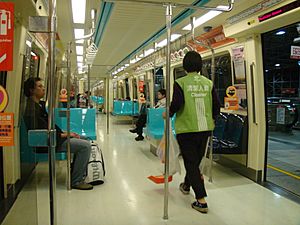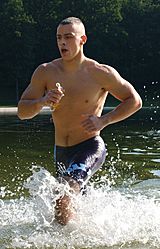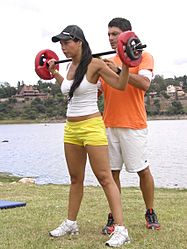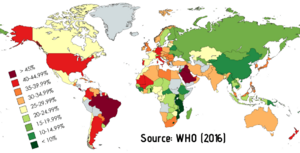Physical activity facts for kids

Physical activity means any movement your body makes using your muscles that burns energy. This includes all kinds of movement, no matter how hard you're working, at any time of day. It covers both planned exercise and everyday activities. These everyday activities might not be planned or done to get fit. They can be things like walking to a shop, cleaning your room, or riding your bike to school.
Not moving enough can lead to health problems. But being more active can make your body and mind healthier. It can also help your brain and heart work better. There are many ways to help people be more active, like school programs, active ways to travel, and community activities. Being active also helps you burn energy, which is important for managing your body weight.
Contents
Physical Activity vs. Exercise
People often use the words "exercise" and "physical activity" to mean the same thing. They usually think of activities done in free time to get or stay fit. However, these two ideas are not exactly the same.
Exercise is a special type of physical activity. It is planned, structured, and done over and over again. You do exercise on purpose to improve or keep your fitness. On the other hand, physical activity includes exercise, but it can also be unplanned, not structured, and done for many different reasons.
Studies show that people who start successful physical activity programs often keep up their activity for at least three months.
How Intense Is It?
Physical activity can be at any level of effort. It can be as simple as a small muscle twitch or as hard as an all-out sprint. Think of physical activity as a scale, from sitting still to very intense movement. We group activities into categories based on how much energy they use. These categories are:
- Sedentary behavior (sitting or lying down)
- Light activity
- Moderate activity
- Vigorous activity
Examples of Activity Levels
Here are some examples of physical activities for each intensity level. Keep in mind that for different people, or depending on how you do the activity, it might fit into a different category.
| Intensity | Example Activities |
|---|---|
| Sedentary Behavior | Sitting, lying down |
| Standing | Standing still |
| Light Physical Activity (LPA) | Walking slowly, moving around the house |
| Moderate Physical Activity (MPA) | Brisk walking, jogging, light swimming, climbing stairs |
| Vigorous Physical Activity (VPA) | Fast running, fast cycling, sprinting |
Being physically active can also help reduce feelings of worry and stress. Moderate physical activity can help lower blood pressure and heart rate.
Global Recommendations for Activity
The World Health Organization (WHO) gives advice on how much physical activity people should do. This advice also includes sleep and how much time you spend sitting.
For Adults (18–64 years old)
1. Adults should do at least 150 minutes (2.5 hours) of moderate-intensity aerobic physical activity each week. Or, they can do at least 75 minutes of vigorous-intensity aerobic physical activity each week. They can also do a mix of both. 2. Aerobic activities should be done in periods of at least 10 minutes. 3. For even more health benefits, adults can increase their moderate activity to 300 minutes per week. Or, they can do 150 minutes of vigorous activity per week, or a mix. 4. Activities that strengthen muscles should be done on two or more days a week. These activities should work all the main muscle groups.
For Children and Teens (5–17 years old)
1. Children and young people should get at least 60 minutes of moderate- to vigorous-intensity physical activity every day. 2. Doing more than 60 minutes of physical activity gives even more health benefits.
Factors Affecting Activity Levels
How much physical activity people do depends on many things. These include age, gender, and where they live. It also depends on their health and culture. The environment plays a role too, like if there are parks or safe places to walk and bike.
Studies show that when there are more natural places like parks or forests, people tend to do more activities like walking and cycling in their free time. Weather can also affect activity. For example, warmer temperatures and less wind can lead to more physical activity.
In 2016, about 81% of students aged 11–17 around the world were not active enough. The region with the most inactive young people was high-income Asia Pacific.
Physical Activity as a Health Check
Some doctors suggest using a "physical activity vital sign" (PAVS) to check how active patients are. This can be a simple screening tool. It can help doctors see if a patient is meeting physical activity guidelines. Often, this is done using a questionnaire where patients report their own activity levels.
See also
 In Spanish: Actividad física para niños
In Spanish: Actividad física para niños
- Physical inactivity





